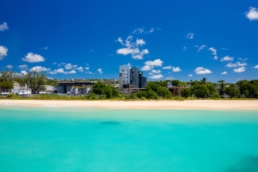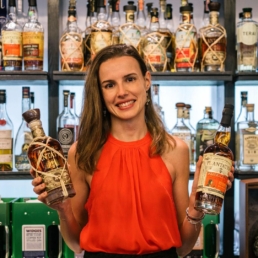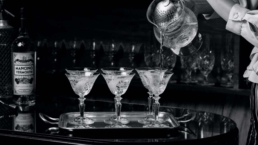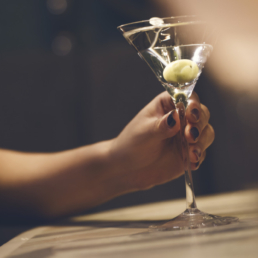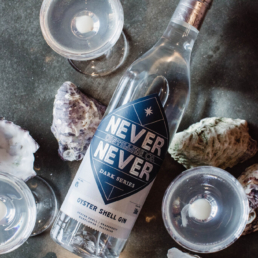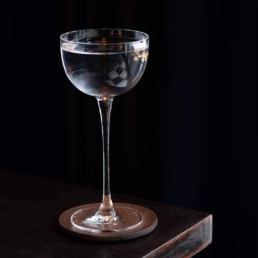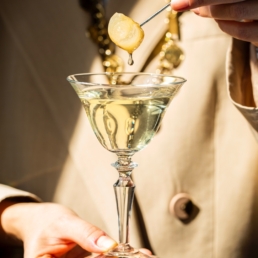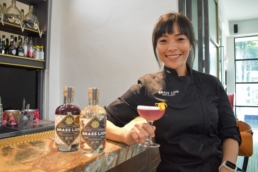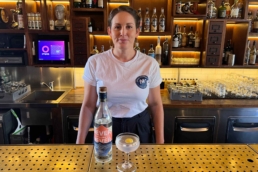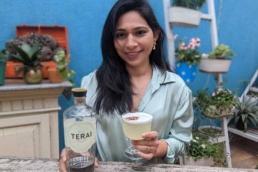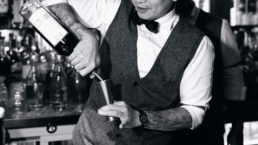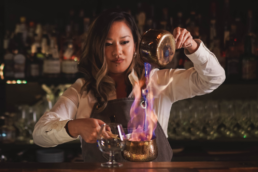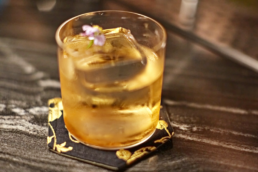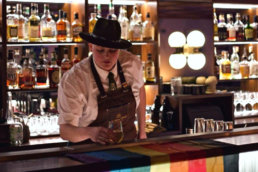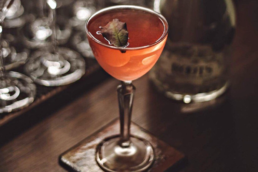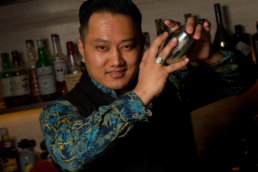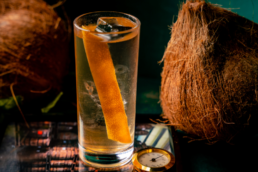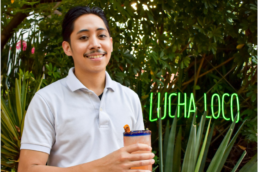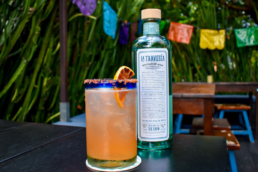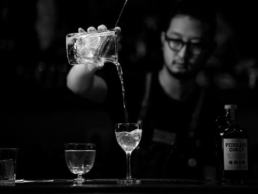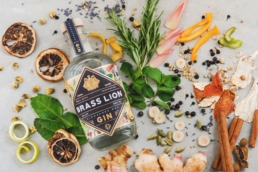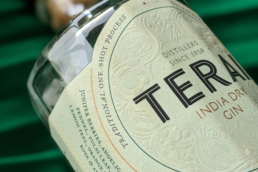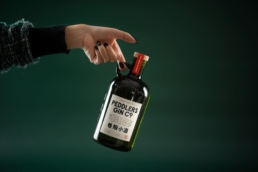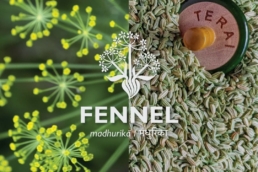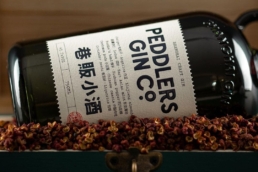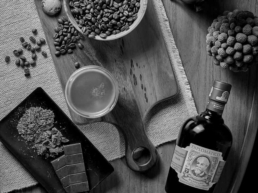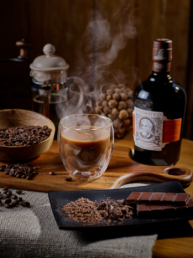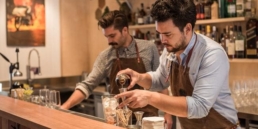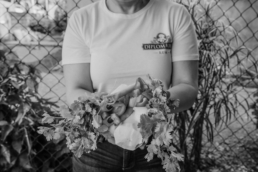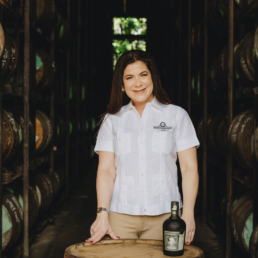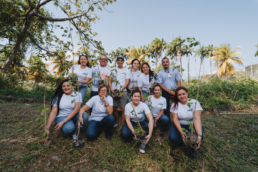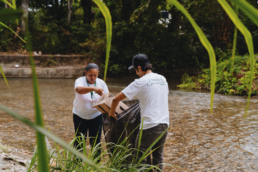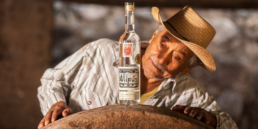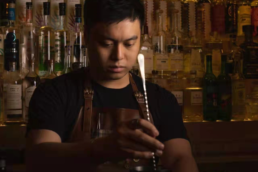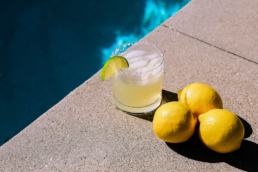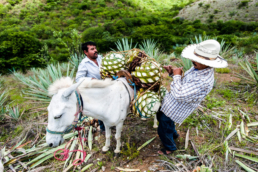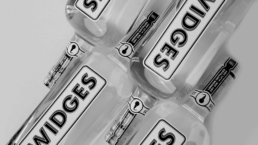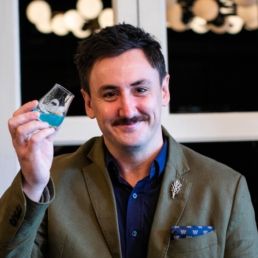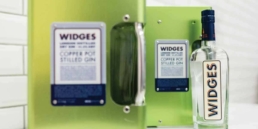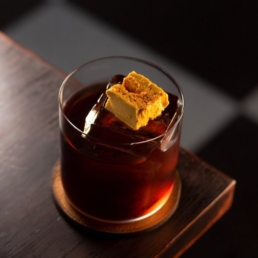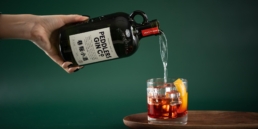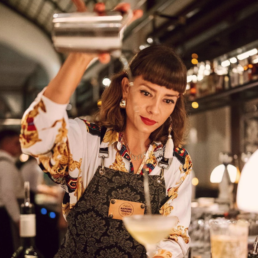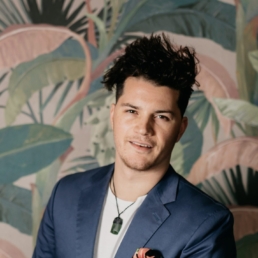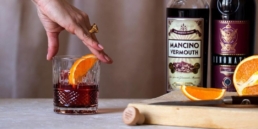FROM BEHIND THE BAR: THE IMPORTANCE OF TERROIR IN RUM
ASIA PACIFIC, 12 APRIL – Rum is a versatile and flavorful spirit that has become a staple ingredient in cocktails across the globe. While it is beloved for its distinct taste, one often overlooked element that sets one rum apart from another is terroir. This concept, which is gaining traction in the world of spirits, emphasises the importance of environmental and cultural factors in shaping a rum’s flavour profile.
Explore the world of rum and terroir with us as we learn about the impact of climate, soil, and cultural practices on the unique taste and character of each rum. From the Caribbean to the Pacific and beyond, this concept of rum and terroir promises to reveal the fascinating complexities and nuances of this beloved spirit.
Terroir And Its Impact On Rum
Terroir refers to the environmental factors that impact the growth and development of plants that make spirits, resulting in a unique flavour and aroma profile. In the case of rum, terroir plays a significant role in shaping the final product. Whether it is wheat, sugarcane, agave, or grapes, at its core, all spirits are agricultural products that start with their plants.
Various environmental factors impact the growth and development of sugarcane used in rum production, such as soil type, microclimate, and native yeast strains. Sugarcane grown in tropical and subtropical areas with high humidity grows faster, undergoes photosynthesis, and produces more sugar. In contrast, drier climates can concentrate flavours into specific parts of the plant, resulting in less yield but more concentrated flavours. For example, sugarcane in Fiji is well known to be high quality and easy to grow thanks to the fertile volcanic soil, while Barbados is the only coral island still producing sugar cane thanks to a perfect combination of sunshine, gentle trade winds and cooling rains.
These diverse terroirs lead to distinct styles of rum. Martinique’s Agricole rum showcases the region’s unique terroir with its grassy and vegetal notes, while Jamaican rum’s robust character reflects the island’s culture and fermentation techniques. Each native yeast strain evolves, adding to the complexities and nuances of when, where, and how a spirit is produced.
Factors Coupled With Terroir
While Mother Nature plays a significant role in terroir, human activity such as farming, cultivating, and production methods (fermentation, distillation, ageing) also contribute to it. For instance, a farmer’s decision on what to plant near the crops can directly affect the soil microbiome and impact the overall character of the spirit. Furthermore, each process step, from harvesting to fermentation, can introduce variations and contribute to the unique qualities of the final product.
Expanding on Jamaican rums, we see how culture influences fermentation techniques, resulting in longer fermentation times and a heavier body to the final rum. The result is an emphasis on full-bodied, strong with funky notes of tropical fruits, wood, rubber, spices sweet caramel and molasses rum that reflect the relaxed lifestyle of the island. Unaged rums are a great way to experience the true essence of terroir, but even ageing can contribute to it. Careful consideration of the type and treatment of wood in the barrel by distillers can enhance or mask the flavour compounds in the final spirit.
Why Bartenders Should Care About Terroir In Rum
Whether served neat or in a cocktail, terroir adds depth and complexity to the drinking experience. Bartenders are cluing into this, drawing out certain characteristics in different rums to highlight and compliment other ingredients. For example, rums from Puerto Rico tend to be drier due to the island’s hot climate and a requirement of one year of ageing brings out vanilla and oak notes in the spirit, making it the perfect base for the rich and spice-heavy Coquito cocktail. Rum from the Philippines can lend itself well to fruit-forward cocktails, due to the hot and tropical climate, showcasing the rum’s fresh, bright flavours.
As consumers seek more elevated drinking experiences, educating them about the terroir of the rum being served can increase their appreciation for the nuances and complexities of the spirit. By learning about the rum’s terroir, customers can gain a better understanding of the origins of the flavours and aromas in their glass and develop a deeper appreciation for the craftsmanship and artistry involved in producing premium rums.
The Terroirs Of Plantation Rum
Plantation Rum has made a name for itself in the world of rum by placing a strong emphasis on terroir and its impact on the taste and quality of its rums. The brand has produced a range of exceptional rums by prioritising terroir and experimentation. One of their standout offerings is the Vintage Collection, which includes the Plantation Venezuela 2010, a rum that showcases the distinctive flavours of Venezuelan rum-making. Distilled uniquely in 2010, it boasts a flavour profile that includes notes of hazelnut and oak-nut, highlighting the country’s terroir beautifully.
Furthermore, Plantation Rum has made significant progress in forging partnerships and sampling tastes from all over the world. Recently, they have worked alongside the West Indies Rum Distillery team in Barbados to reconstruct a long-unused 19th-century pot still and have even gone so far as to attempt to use sea water in a fermentation batch to test how the yeast will interact.
“Rum is the most diverse spirit in the world. Plantation Rum‘s mission is to showcase the great Terroirs of rum. We invite each one of you to discover the flavours of the different Terroirs of rum through fascinating expressions, each of them defines by unique savoir-faire and a double-ageing technique.
We continuously study the techniques of rum making, which we find fascinating. The beauty and uniqueness of rum remain in the diversity of cultures and production techniques. This is a precious heritage that should never be undermined by any self-interest. Some islands or rum producers won’t make rum the same way, the rum will be influenced by their heritage and practices. This must be respected and understood because it is the very essence of rum, and what makes it so special.”
As the rum industry embraces the significance of terroir, Plantation Rum has raised the bar by prioritising terroir in their production process. This has yielded an array of imaginative and high-grade rums with distinctive flavours native to their region. With the spotlight on terroir, consumers will certainly admire the finesse and proficiency used to produce such remarkable beverages. There is no better way to traverse the world in a glass and savour the genuine taste of place.
FROM BEHIND THE BAR: THE MARTINI RESURGENCE
ASIA PACIFIC, 21 MARCH – The martini is more than just a cocktail; it’s a symbol of an era of sophistication and elegance that still captivates us today. As the world of mixology continues to evolve, this classic cocktail is making a big comeback. With the rise of home bartending and a renewed appreciation for classic cocktails, the martini is experiencing a renaissance in popularity. Its enduring sophistication has captured the attention of a new generation of cocktail enthusiasts, sparking a renewed interest in this timeless libation.
What’s driving this resurgence of the martini? According to Bobby Carey, Proof Creative’s Senior Bar Consultant, the rediscovered appreciation of the martini is partly due to the practical economic motivations of customers. With the rising cost of goods and living expenses, people are looking for more value for their dollar, and spirit-forward cocktails like the martini provide just that.
“Quality over quantity is key as individuals will look to maximise their nights out and have the best and most impactful experience.”
However, it’s not just economic motivations that are fueling the martini’s revival. Lockdowns and social distancing measures have inspired people to get creative with their at-home entertainment, leading to a deeper appreciation for cocktail culture and a growing demand for craft and artisanal spirits. Consumers are taking the time to learn about the basics of cocktails, tasting flavours, and understanding the backgrounds of spirits. This has not only deepened their knowledge of cocktail culture, but has also further fuelled the increasing use of craft and artisanal gins, vermouths, and bitters in drinking establishments.
“This has created a whole new group of people who have a deep appreciation for classic drinks. These more informed consumers also place a high value on the quality of ingredients and the sourcing of spirits, leading them to seek better drinks at bars,” Maison Ferrand’s Senior Brand Manager, Maylis Berger says.
Bartenders and bar owners are catering to this renewed interest by creating innovative variations of the classic drink. For instance, the ARGO Bar at Four Seasons Hong Kong collaborated with Never Never Distilling Co. to produce a unique and delicious gin that includes 3 types of Chinese tea, matured in ex-Chardonnay barrels, and seasoned with Mancino Secco Vermouth under vacuum, for the driest Argo Martini. Similarly, Teresa Bar offers a modern Kaweka Martini made with foraged ingredients in New Zealand, Tarata and Horopito mixed with Mancino Vermouth Secco, perfect for guests looking for something extra special.
And the innovation does not stop there. Brand owners are also exploring various gin varieties to create stunning Martini variations. Never Never Distilling Co., for instance, has created an Oyster Shell Gin that makes for an exquisite Martini with its wax flower and salinity flavour profile. Peddlers Gin, on the other hand, infuses its gin with ingredients commonly used in Chinese medicines and cuisines, such as Buddha’s hand, Sichuan pepper, Chinese cassia, lotus flower, and more, which gives the drink a unique character. Bartenders can then adjust the amount of dry or sweet vermouth to complement the gins when creating these cocktails.
The contemporary craft of the martini is not just about mixing finesse, but also the use of high-quality ingredients. One key ingredient making an impact on the martini scene is Mancino Vermouth, which is renowned for its balance of sweet and bitter flavours and traditional production methods. This extraordinary spirit has allowed bars and home bar owners alike to create a range of martinis that come close to the classic form, providing a welcome contrast to the overly sweet concoctions of the ’90s.
The martini’s resurgence shows no signs of slowing down, and with the growing interest in craft and artisanal spirits, it’s no surprise that Mancino Vermouth Secco has become an essential ingredient in bars around the world. Founder Giancarlo Mancino believes that consumers will continue to appreciate this classic cocktail while seeking innovative ways to enjoy it throughout the year. Like an espresso, the martini is best enjoyed at the bar counter with your favourite bartender, and Mancino Vermouth is poised to play a vital role in elevating the modern martini experience.
PROOF ADVOCATES PAY TRIBUTE TO EXTRAORDINARY WOMEN THIS INTERNATIONAL WOMEN'S DAY
ASIA PACIFIC, 8 MARCH – International Women’s Day is a time to celebrate the resilience, strength, and determination of women worldwide. To honour the inspiring women in our lives, what better way to do so than with a signature cocktail that captures their essence? This time, we highlight some exceptional cocktails crafted by our Proof Advocates, who were each inspired by the remarkable women in their lives.
Kino Soh, the Brand Ambassador of Brass Lion Distillery, created the Dragon Lady cocktail as a tribute to her mother’s persona – sophisticated and bold. Her mother’s unwavering dedication to providing for her family and her outstanding cooking prowess gave her the impetus to become the best version of herself. This bright and complex beverage was put together with Brass Lion Navy Strength Gin, Brass Lion Butterfly Pea Gin, Mathilde Poire Liqueur, Calamansi Cordial, Lemon and Foamee, using Singapore’s botanical blends to give it a distinctive flavour profile. Mathilde Poire Liqueur adds a subtle sweetness to the cocktail, while the Calamansi Cordial gives it a bright, citrusy kick. The creamy texture of the foamee brings everything together, making the Dragon Lady a well-balanced and flavourful tribute to Soh’s mother.
Shay Chamberlain, the Brand Ambassador of Never Never Distilling Co., found inspiration in Australian tennis legend Ashleigh Barty when crafting her cocktail. Barty is a former professional tennis player and cricketer who has made a name for herself as one of the best athletes in the world. Chamberlain was inspired by the athlete’s commitment to excellence and wanted to honour Barty’s spirit of strength and determination. Her “Barty” Martini is strong and flavourful, made with the award-winning Never Never Triple Juniper Gin. This delicious craft gin is made with native Australian ingredients and delights drinkers with the bright and earthy qualities of juniper. With its bold and spicy flavour profile, this cocktail also celebrates all powerful women who inspire us to be our best selves.
Maylis Berger, Senior Brand Manager for Maison Ferrand, created the Citadelle Jardin Gin & Tonic to celebrate her mother’s strength and positivity. This beautifully crafted cocktail uses Citadelle Jardin D’Été Gin, balls of fresh melon (which happens to be her mother’s favourite fruit) and a lemon twist. Citadelle Jardin D’Été Gin is a premium craft gin made in France and offers a delightful combination of sweet and zesty flavours. The fresh melon adds a nice sweetness and the lemon twist adds a wonderful zing to the cocktail, resulting in a sweet and refreshing drink that honours her mother.
Karina Aggarwal, Vice President of India Craft Spirit Co., celebrates her mother with an exquisite TERAI Gin Fizz cocktail that captures her mother’s radiant spirit. Aggarwal’s mother, who she describes as the smartest woman in her life, embodies kindness and a constant thirst for learning. The cocktail’s recipe features TERAI India Dry Gin, lime juice, honey syrup, egg white, and a splash of soda, resulting in a sweet and refreshing blend that stands the test of time. TERAI India Dry Gin is one of the most exceptional craft gins hailing from India, meticulously handcrafted in small batches. Its unique botanical blend is inspired by the Terai region, a lush green oasis nestled at the foothills of the majestic Himalayas. A beautiful gin to befitting for a luminous lady.
These beautiful cocktails embody the intricate flavours that are a homage to the amazing women in our lives, who hold an inspirational spirit that connects us all. On International Women’s Day, let us join in a toast and salute all the incredible women in our lives and their extraordinary spirits.
PROOF & COMPANY CELEBRATES BARTENDERS ACROSS APAC ON WORLD BARTENDER DAY
ASIA PACIFIC, 23 FEBRUARY – This World Bartender Day (24 February), Proof & Company is proud to celebrate the incredible bartenders across Asia Pacific who have shaped the industry for generations to come. From innovative mixologists to dedicated bar owners, we’re excited to shine a spotlight on the talented professionals across the region who are redefining and elevating the cocktail culture. Let’s take a look at five of the inspiring bartenders who are making waves in their communities.
Chau Tran, co-owner of the Burrow Bar and Cash Only Diner in Sydney, is a respected and much-admired figure. After completing a degree in marketing and commerce, she worked her way up in the bar industry, starting as a bartender and progressing to the roles of barback, venue manager and finally general manager. In 2016, Tran achieved her goal of owning a venue, joining forces with her best friend Bryce McDonough to open Burrow Bar. The small boutique cocktails and spirits bar was even nominated for a series of awards, including Australian Bartender Magazine’s Bar of the Year, NSW Bar of the Year and Small Bar of the Year for 2019.
Tran further established herself in the industry by becoming the 2019 Global Winner of the Gin Mare and earning second place in the Bar Convent Brooklyn cocktail competition in 2020. Additionally, Tran and her team initiated the hospitality pro-bono marketplace Hospo Threads to provide aid to the hospitality industry, in addition to cooking and delivering more than 10,000 meals to those in need during the pandemic.
When asked what was Tran’s signature drink, she presented Farmer’s Market made with Never Never Juniper Freak Gin.
“This drink sums up Burrow Bar in a cup for me – a joyous hug on the inside from a dear friend. It’s the same feeling I get when let loose at a unique grocery store or wandering around a farmer’s market on a Saturday morning. It is a a drink that celebrates Spring and a drink that reminds me of my favourite time of my week.”
Harry Zhang’s impressive tenure in the cocktail industry began at the Equis Bar of the Four Seasons Hotel Beijing, where he spent two years studying techniques before transferring to the UNION Bar at the Opposite House. During that time, both bars earned the prestigious Drink Awards for the Best Hotel Bar in China.
In his work at UNION Bar, Zhang has dedicated himself to producing modern cocktails that challenge him to find ways of unlocking the full spectrum of flavours and the taste profiles of his drinks. A fitting culmination of his creativity is the Silk Road-inspired bubble punch cocktail that has become his signature.
Blended with Peddlers Rare Eastern Gin and Sichuan E’mei mountain snow jasmine tea, the delicate yet bubbly punch is the embodiment of Chinese flavours. The intensity of pepper is balanced with passion fruit and bergamot, while the final result is an exotic drink with a unique blend of floral, fruity, and spicy notes – making it the perfect beverage to savour in this modern cocktail bar.
Meredith Earle has been a successful presence in New Zealand’s cocktail industry for 10 years, even taking her talents to festivals such as Rhythm n Vines, Bay Dreams, and many other musical gigs throughout Aotearoa. Working under the mentorship of Matt Barnsley at Austin Club, Earle gained invaluable experience as the second-in-charge at the 1950s-style speakeasy. Drawing on and utilising the wealth of native New Zealand ingredients, her excellence in the field saw her crowned winner of both the Show Us Your Roots and Step into Never Never Competition in 2022. Recently, Earle crossed the seas and began her journey at Black Pearl, Melbourne to further her exploration of cocktail concoctions, as well as the local produce and landscapes of Australia.
Earle’s signature cocktail has been a personal favourite, with the components themselves reflective of the Aroha (love) she has for her mother and her roots. Sustainable and full of foraged ingredients and fresh produce, the concoction also incorporates Roots Gin and horopito, embodying the Maori heritage that lies close to her heart. A salt garnish serves as a reminder of the salty sea air near her family’s urupā (cemetery) in Kawa Kawa Bay, an area in which Earle is able to relax and truly feel at home. But the most special part of her concoction lies in the rose cordial, made with love by Earle herself.
“The homemade Rose cordial is a good balance of sweet and sour, inspired by my mother Joanne Rose Earle and her mother Alice Rosie Williams. These two women are my roots and have made me who I am today.”
Drawing from his years in Hong Kong’s F&B industry, Maikal Gurung is highly renowned for his invention of cocktails and the tutelage he provides to inexperienced bartenders. Gurung has served as the Head Bartender of Lobster Bar in Shangri-la Hong Kong and, having the spirit for new explorations in the world of cocktails, he is now the General Manager of The Daily Tot. With the freedom to freely express himself through the creation of cocktails, today Gurung guides the team of rum makers and youthful bartenders as they venture through the realm of rum.
With The Daily Tot’s passion for extraordinary rum, it’s only fitting that Gurung’s signature cocktail features the distinctive Plantation Rum. Inspired by Vice-Admiral Edward Vernon’s navy grog “recipe” from 1740, The Tot Grog gives an updated spin on the traditional drink with its blend of coconut water, coconut soda, and Plantation Rum. The refreshing result is a nod to its history, paying homage to its past while creating a modern concoction that energies guests.
Nursham Affiyan bin Abdul Rahman, otherwise known as Sham, is the bar supervisor at Lucha Loco, a festive eatery nestled within the concrete jungle of Singapore’s Duxton Hill. This converted shophouse boasts delicious Mexican cuisine as well as a hidden garden, and Sham’s passion for aged agave spirits and artisanal mezcals brings even more authenticity to the place. When concocting a cocktail, Sham loves to have fun and add a bit of zing to the drink with an assortment of bitters.
A prime example of his handiwork is his signature, Fiery Paloma. The sweet, fiery scent of the classic cocktail, enhanced by firewater bitters, combined with the candied and smooth La Travesia is an olfactory journey reminiscent of a spirited Mexican afternoon. His creative artistry is infused with enthusiasm and panache – it is what distinguishes his work from the rest.
FROM BEHIND THE BAR: THE EMERGING WORLD OF ASIAN GINS
ASIA PACIFIC, 31 JANUARY – The world of Asian Gins is an ever-evolving and growing phenomenon, one that has seen an incredible boom in recent years. From India to China to Singapore, and everywhere in between, distillers across Asia are producing some of the most remarkable spirits the world has seen. And it’s no surprise, given Asia’s incredible cultural, geographical, and culinary diversity, as well as its remarkable economic growth in recent decades.
To gain an understanding of the rising trend in craft gins, we interviewed some of the pros in the Asian Gin community. They have been championing regional flavours and incredible stories through their extraordinary spirits.
VERSATILITY OF GIN
With its multifaceted, flexible character, gin serves as an ideal vehicle for infusing a broad range of botanicals, herbs, spices, teas, and fruits native to Asia – a feat that many spirits cannot compare to. This presents craft distillers with a wonderful chance to put an imaginative spin on local botanicals.
“Gin as a drink occupied a fairly unique space when it comes to spirits—there is much less discourse and judgment on ‘how not to drink’ it as compared to other spirits; it is also very versatile in how bartenders, enthusiasts, or casual drinkers can play with it to customize it to their tastes.”
Founder of Brass Lion Distillery in Singapore, Jamie Koh, agrees “So much of gin-making is about the provenance of ingredients, and I think it’s great that each country in Asia can stamp its mark on the industry by highlighting its local botanicals.”
HOME TO AN AMAZING ARRAY OF UNIQUE BOTANICALS
What works particularly well for Asian craft gin distillers lies in the great variety of botanicals available in the diverse region, allowing for a plethora of possibilities and more flavour-forward craft gins.
As Aggarwal states, “We have access to indigenous botanicals that have enabled each brand to craft something truly distinct and uncover lost stories. For TERAI, the botanicals chosen were selected to emphasise Indian familiarity while breaking away from the traditional cardamom and pepper combination.”
With one of the world’s most diverse and sophisticated food cultures, China offers a variety of flavours to draw upon. Peddlers Gin calls upon the wealth of flavours that the country has to offer, such as Buddha’s Hand from Yunnan, Sichuan peppers, and lotus flowers from Ganshu, to deliver a complex, distinctive and balanced flavour profile. “Ultimately, we wanted to create a gin that was unique to our region but could stand alongside the best on the world stage,” explains Joseph Judd, Head of Brand at Peddlers Gin Company.
Similarly, Koh seeks to tell the story of Singapore and its local heritage to the world.
“As a centuries-old trading port, we’ve been pivotal in the transportation of spices from east to west. This, on top of our multicultural society, allows for a beautiful melting pot of ingredients that help to make our gins uniquely Singaporean.”
BOOMING DRINKING CULTURE IN ASIA
The trend of craft gins has grown immensely over recent years, a phenomenon attributed to expanding drinking culture and changing regional preferences. Consumers are becoming increasingly interested in experimenting with new spirits, in search of those that suit their personality, hence leading to an abundant variety of inventive products hitting the shelves.
In India, the gin market has grown significantly and spawned multiple domestic labels. “Observing customers go from enthusiastic supporters (of multiple brands) to favouring one product over the other has been fascinating,” says Aggarwal. Merely creating a gin isn’t enough nowadays; it must possess something distinctive – in terms of flavour, branding, or backstory – to stand out.
In addition, the flourishing cocktail culture has prompted many to start showing a greater interest in gin and different gin-based concoctions.
“We are fortunate to have played a tiny part in the thrilling and innovative cocktail culture in Shanghai which is beyond compare. There are multiple great cocktail bars in the city such as Union Trading Company, E.P.I.C. and Shake, among many others, that have raised the bar and we have seen numerous amazing concepts coming up since, each of which is contributing to the scene in its unique way.”
While the world grows increasingly aware of the extraordinary offerings these countries have to offer, the years ahead are looking incredibly exciting for craft gin in Asia. Craft gin distillers are in the unique position of being able to bring awareness to the various places that provide the source of the flavours they bring to their gins.
As Koh remarks: “We hope to continuously innovate while staying true to our roots. We’ve created our own lane and we plan to stay on it – highlighting the beauty of our local botanicals and striving to create spirits that represent who we are.”
ABOUT BRASS LION DISTILLERY
The birth of the idea came back in 2012 when they were looking for a spirit crafted here in Singapore. After embarking on a six-year journey to create a spirit that can truly encapsulate the heart of Singapore, Brass Lion Singapore Dry Gin was brought to life.
Building upon classic gin foundations of juniper berries and coriander seed, the first Singaporean micro-distillery introduced traditional Asian flavours such as the aromatic torch ginger flower and citrusy lemongrass. The result? A smooth, vibrant spirit that is the quintessential expression of The Singapore Dry Gin – a true reflection of the cultural melting pot that is Singapore.
For more information, please visit Brass Lion Distillery.
ABOUT TERAI INDIAN DRY GIN
Founded by the Swarup Family in India, TERAI India Dry Gin is a modern gin rooted in London Dry Gin traditions but with an intrinsically Indian flavour profile and character. It is a vibrant gin that begins with lush green notes lifted by citrus zest. This is followed by a characteristic floral bouquet and a sweet and piney juniper aroma. On the palate, sweet and herbaceous flavours are balanced by a dry spice and savoury finish. TERAI combines the love for our land, expertise in distillation and agriculture, a Spirit of Craft, and a devotion to a good drink to bring you the true India Dry Gin.
For more information, please visit TERAI India Dry Gin.
ABOUT PEDDLERS GIN COMPANY
Peddlers is a Shanghai gin company started in 2017 with a vision of challenging perceptions of what it means to be ‘Made in China’. Using uniquely Chinese ingredients like Sichuan Pepper and Buddha’s Hand, Peddlers Gin tells a story of diverse regions of China. With exports of their premium gin to over ten countries throughout the Asia Pacific, and triple-digit sales growth, Peddlers is proudly representing Shanghai to the world.
For more information, please visit Peddlers Gin Company.
FROM BEHIND THE BAR: COFFEE MEETS COCKTAILS
ASIA PACIFIC, 21 DECEMBER– The delicious mix of coffee and craft spirits, two of the world’s greatest pleasures, has been quietly growing up with the second Golden Age unfurling globally.
Certainly, individuals have been elevating their coffee by adding spirits long before cocktail culture emerged, but the surge of coffee cocktails in the modern canon has been bolstered by two drinks from the last century: the Irish Coffee in the 1940s and the Espresso Martini in the 1980s. Both are fairly simple cocktails that let the coffee shine, they’ve inspired a movement to combine coffee and spirits in cocktails all over the world.
In Australia, coffee culture has long been at the forefront, with baristas and roasters taking it just as seriously as the cocktail scene takes their mixology. Charlie Ainsbury, Senior Bar Consultant at Proof Creative confirms this notion, “Coffee is synonymous with Australia, dare I say that if there was a capital of the Espresso Martini, we would be it.”
“The complexity and familiarity of coffee just show how diverse the humble coffee bean can be depending on how you choose to extract its flavour. It can be dark, rich, and bitter and it can also be light, silky, and fruity. I also enjoy the immediate affinity guests have with coffee in cocktails.”
Seemingly simple on the surface, coffee’s taste and aromatic profiles are complex and can range from fruity to earthy, bright to rich, spiced, and chocolaty, all with some signature bitterness. Like any agricultural product, coffee beans evoke the terroir from where they are grown, with different roasting and production methods coaxing out a spectrum of flavours before it gets to your cup. The complexity and versatility of the beans are not only what make it such a vastly intriguing beverage on its own, they also make coffee ideal to utilise in cocktails.
“Well, there is the obvious energy boost but also coffee can be used in so many ways from being the main flavour in a cocktail. The roasted bitterness from the coffee compliments many other flavours like citrus and dark berries,” General Manager of 28 HongKong Street, Chris Peart explains, “Coffee also mixes with most liquor categories – whisky, rum, agave, fruit liquors… There are many possibilities when using coffee in lovely tipples!”
For the true connoisseur ready to develop their own recipe, consider what characteristics coffee can bring to your cocktail and highlight or contrast from there. Bright lemon, toasted pineapple, caramelised oak, nutty coconut, and rich chocolate each make fantastic compliments to different beans and roasts. Select a direction for your cocktail, then build it out with supporting ingredients to tie it all together, working with the complexity of the coffee.
If you just want to dip a toe in the waters of coffee cocktails, the Espresso Martini, Irish Coffee, or Carajillo won’t disappoint. A self-proclaimed Espresso Martini lover, Peart explains what makes a great tipple.
“A good one is usually made using a spirit other than vodka. Personally, a good dark rum like Diplomatico Reserva Exclusiva, or an Anejo tequila. The coffee liqueur should be something decent but not super dry and still have some nice sweetness to it that goes really well with some freshly made espresso. You should also be good at using a coffee machine! Finally, a few dashes of saline can be a nice addition. Keep it simple with quality ingredients across the board.”
These simple cocktails keep coffee front and centre with big, bold taste profiles. When you’re ready to brew up your own signature style, think of coffee as a supporting flavour, in tandem with the base spirit. Any spirit can work with coffee in the right preparation, but beginners can start with rum, bourbon, or vodka. When ready to level up, try working with gin, mezcal, or amaro. Coffee also works well when updating classic cocktails, whether spirit-forward, like an Old Fashioned or Negroni, or refreshing and citrus-based, like a Daiquiri or Sour. Ainsbury will most likely gravitate to something with barrel age, or richness in spirit but it can be eye-opening to challenge yourself to do the opposite.
Whatever direction, the coffee must be brewed fresh. This will allow for the best concentration of true flavours from the beans. Incorporate chilled espresso into a syrup or try cold brew for long drinks. For garnish, use whole beans, grate over a Microplane for zest, or mix into a salt or sugar rim.
Ainsbury shares, “Your base ingredient of coffee doesn’t just mean espresso. Experiment with as many methods of extracting flavour as possible, with different levels of roast and using different terroirs. When you do, experiment again! The possibilities are infinite, every person has a personal favourite type of coffee drink so let yourself go wild.“
SUSTAINABILITY AT THE HEART OF DIPLOMÁTICO RUM
ASIA PACIFIC, 22 NOVEMBER – The sustainability campaign is starting to take hold of the craft cocktail industry as one of the main subjects within this new contemporary culture. As rum is one of the most scrutinised spirits, the industry is evolving into one which is implementing and practising sustainable operations. Within the last years, Diplomático Rum started on a mission to emerge as leaders beyond the bar by tackling key sustainability issues, people, processes, and the environment.
In fact, the Venezuelan brand recently designed the “Distilled Consciously” program, which shows their commitment to prioritize doing business more responsibly, getting people involved in their projects, and making positive changes for the next generation of passionate rum-makers.
The process of manufacturing rum can be detrimental to the environment in various ways, from the careless disposal of sugarcane vinasse to the absence of proper recycling. However, what unites the industry is a growing focus on sustainability, and today, distillers are slowly recognising the significance of the relationship between rum and the environment.
A field that has been gaining traction in the industry is distillery’s waste processing research, and Diplomático Rum started zeroing in on slashing energy consumption, conserving precious water resources, and upcycling by-products. Leveraging an internal recycling system that recycles 100% of solid and liquid waste – including vinasse – the process transforms this liquid waste into organic fertilizer that feeds the cultivation of over 1,000 hectares of sugarcane cultivated by 26 family-owned farms in their vicinity. In addition to reducing fuel costs by 48% with their cogeneration technology and water usage by 50% thanks to energy-saving processes, Diplomático Rum also recycles nearly 270 tons of solid garbage per year through their recycling centre.
“Our main focus is on minimizing the environmental impact of each and every one of our operations and taking it one step further by committing to our surroundings beyond the distillery.” explains Mariela Ballesteros, Head of Corporate Communications at DUSA “With over 16,000 trees planted since 1992 through an active reforestation program, the Diplomático Rum brand actively contributes to increasing biodiversity and leaving a green footprint.”
Diplomático Rum has received multiple international awards and recognitions that show it is remaining faithful to its family values: responsibility, integrity, and preservation of the environment. And advocacy has always been an integral component of the elaboration of Diplomático Rum.
This value is reflected in their movement of inspiring customers and bar folks alike to participate in activities and raise environmental consciousness. Through collaborations with NGOs and other partners through monthly local beach cleanups and investing in local communities projects, it is this continuous dedication that makes them “The Heart of Rum”.
“As a family business, we consider our people to be our best asset. Our commitment is to direct all our social investment to improve the life quality of our workers as well as of the local community with special focus on health care.”
Social initiatives were also launched worldwide to fight against food waste with its partners, distributors, and consumers’ support. For example, the pilot program “USA Project Leftover,” where food is directed to those in need instead of wasting it. The goal is to get at least 39,000 pounds of food from at least 100 restaurants to give to people in need. Furthermore, Diplomático Rum was a crucial part of “Canada Zero Waste” Working with Second Harvest, the country’s largest food rescue organization, on their latest campaign, “Donate the Difference”.
“Our sustainability program is the result of the engagement and voluntary commitment of all our employees, partners and distributors who share the Diplomátic Rum values and beyond all genuinely understand the importance of protecting our natural and Human Resources,” José Rafael Ballesteros, CEO of Diplomático Rum shares.
Ever evolving, producers are starting to answer the question: How does one sustainably make high-quality Rum? While the act of drinking cocktails will never reconcile itself completely with the environment, brands such as Diplomático Rum are seeking better decisions and innovations to limit the global impact.
ABOUT DIPLOMÁTICO RUM
Diplomático Rum is passionately crafted by Maestros Roneros, using their expertise in combining modern and traditional distillation methods to produce exceptional rums for demanding palates. Every drop is infused with a rich and treasured heritage that comes from the heart and reaches out to yours. In 2018, Diplomático was awarded Wine Enthusiast’s prestigious “Spirit Brand of the Year,” the first-ever rum to win in this category. Having produced top-quality spirits since 1959, Diplomático’s distillery combines traditional methods with modern technology to produce the finest of rums.
For more information, please visit Ron Diplomático.
FROM BEHIND THE BAR: THE RISE OF MEZCAL
ASIA PACIFIC, 21 OCTOBER – Mezcal is one of the world’s most artisanal products, with wide variations in style, and a story behind every bottle. The smokier sibling of the also agave-based tequila, mezcal has been captivating audiences around the world. Created by cooking agave inside earth pits over charcoal and wood before distilling in clay pots, the result is a distinctive smokiness and deep, earthy notes that discerning drinkers and bar folks have come to love.
After being de-marketed in for its supposed hallucinogenic elements, Mezcal was given a second chance in 1994 when local regulations and official certifications were made to govern its production. The spirit developed from being known as a Mexican liquor with a worm in the bottle in the 2000s, to a highly revered bona fide contender not just among agave spirits, but spirits at large. — this paragraph needs rewriting, it probably only needs to be a sentence, “as recently as the 2000s, mezcal was known as the Mexican spirit with the worm in it,” or along those lines.
But as the world discovered quality tequila, they also took a fresh look at mezcal. This newfound popularity means that mezcal producers are reaching more people than ever before.
“With the rise of the popularity of tequila, people are looking to explore the agave category,” explains Luke Sanderson, Advocacy Director of True Believers, “Locally, accessibility was difficult for many years, we just couldn’t get our hands on it but now we have one of the best agave bars in the world here in Australia, Cantina OK!”
“From distributors and suppliers to bars, everyone is importing and having more stocks of agave spirits. Every bar will stock at least one kind of agave spirit; some bars will stock more than two kinds of mezcal. All our local bartenders have been learning more knowledge of mezcal and tequila.
The whole beverage industry has been promoting agave spirits, not only in mainland China but also on a global scale. It would be a new trend in the cocktail scene for sure!”
Mezcal is also coming into its own as a cocktail ingredient, explains Sanderson. He further elaborates that Mezcal has a taste profile traditionally reserved for the whisky category and Islay with its bold smokiness. But today, it is a true exploration of these notes in our cocktails in a light and fresh way.
Leung affirms the depth that mezcal brings to cocktails. “Making a cocktail with mezcal gives the cocktail more layers, thanks to its bold smokiness of it. Every classic cocktail I have made with mezcal so far is all very well balanced on the palate and delicious.”
Not only does this extraordinary spirit create opportunities for bartenders to dabble in cocktails with the discovery of flavours, but it’s also a chance for customers to experience something a little different.
If you’re new to the spirit, there are a couple of guidelines to keep in mind.
Mezcal is like wine in that it is expressive place and terroir-driven. Agave is an agricultural product, like wine, with its own harvesting period — typically it takes seven to eight years for an agave to mature. The most commonly used agave species for mezcal is espadin, with tobalá, tobaziche, tepeztate, arroqueño and many more.
Some mezcals are more vegetal, some are floral, and some are sweet and have notes of honey. Others are nutty, or earthy, or taste strongly of minerals. Sanderson recommends trying everything and create a reference point that will assist in exploring the other regions flavours. While if you are looking for a rich, fruit-forward flavour, Robin would highly recommend tobalá mezcal.
But as mezcal grows in popularity, so does the demand on production, and — as Sanderson anticipates — there will be pressure to use automated production techniques using large-scale production and high-end equipment like fibre optic refractometer, fractionator, diffuser and more to meet demands.
This popularity is something Leung is cautious of. “For the sustainability and future of distilling mezcal, I’m hoping that practices and regulations are put in place to ensure the continuation of agave cultivation to prevent the overconsumption of agave.”
This is why it’s important to choose sustainable mezcal brands. These environmentally and socially conscious businesses help to ensure the resilience of mezcal, both as a spirit category and as a cultural story. It’s possible for mezcal to stay true to its roots, after all, mezcal’s small-batch independence and quality are exactly what consumers are looking for.
FROM BEHIND THE BAR: WORD FROM WIDGE
ASIA PACIFIC, 13 OCTOBER – Not many people in our industry can say they have their face on a bottle of gin, yet the award-winning Australian bartender Jason ‘Widge’ Williams can. Having been around gin nearly his entire life, we tap into our Head of Advocacy’s love affair with all things gin and how his face landed on the packaging of one of Asia’s favourite craft gins.
A young 13-year-old Williams picked up the nickname ‘Widge’ when he first dipped his toes into the hospitality industry, washing dishes at a local pizza shop. The nickname stuck with him as he progressed through the bar industry, riding the wave of the early 2000s cocktail scene, falling in love with the creativity, history and social dynamism that great drinks could bring.
“There is something absolutely magical and rewarding when combining ingredients, and flavours and introducing guests to new drinking experiences,” Williams says.
Shaking and stirring his way into the world of extraordinary spirits, Williams won the Beefeater 24 Global Bartender Competition, which took him around the globe, exploring gin distilleries – and that was when he properly fell in love with the category.
“I’ve spent a decade visiting distilleries and I’ll never not miss the heady, spicy smell that just hits your nose once you’ve opened the distillery doors. It is hard to not love a genuinely handcrafted product. From the selection of natural ingredients, sourcing the best botanicals, and weighing by hand – it is extremely hard to totally automate or digitalise the gin business. It’s a hand-touched process, and you don’t get it in many other mainstream other spirits categories.”
To fall for gin is to embark upon a lengthy journey. Before collaboration was a norm in the spirits industry, Williams went on to open a gin speciality bar with 80 gins in Sydney, The Rook and was the first to collaborate with Four Pillars, one of the biggest Australian gin brands, in co-creating the Four Pillars Spiced Negroni Gin.
By now known as the ‘gin guy’, Williams further enhanced his reputation when he arrived in Singapore and was part of the team to launch the opulent ATLAS Bar with Proof & Company. Heavily focused on the art deco period, the bar celebrates gin with a carefully curated collection of over 1,300 gins including an Archie Rose Distilling Co. collaboration and a permanent St George’s Distillers ATLAS Orange Gin. From this point, Williams became a bonafide gin aficionado; running the Juniper Society and became the first person from Singapore to be inducted into the London Gin Guild. Not surprisingly, the title Master of Gin at ATLAS was bestowed to Williams.
So how did Widges Gin come about?
“Proof & Company was working on True Believers range of brands. The whole ethos of True Believers is to bring world-class spirits to the mainstream by promoting independent drinking, working with world-class distillers and being utterly transparent so that we can bring to drinkers a spirit valuable to the modern-day bartender at a competitive price point.
Spencer Fornhart, one of our founders, recognised my experience and reputation for gin education and advancement and tapped me to work on the developing of our gin to grace the bars of Asia Pacific. I was recruited into this new exciting product launch.”
“The first thing I thought of was, “What does the bartender actually need, especially when there are already a plethora of amazing gins?” This gin has to really work in a G&T and a dry gin martini.”
The botanical perspective was considered next. For this, he gravitated towards a classic backbone of juniper and dry herbs, but they loved the idea of elevated citrus. Williams loves that citrus element of gin in sour-family cocktails such as the White Lady and Aviation – both done with an orange liqueur. “Orange is also a very dominant character in a negroni and in a stirred cocktail like a Hanky Panky and has a lot of uses: tea, cleaners, repellent, cosmetics, cooking,” says Williams. “It’s like vanilla in the cocktail world. I then considered the things I love that will bring out the orange and juniper – cardamom”.
They took this brief to Langley in the UK and perfected the recipe — it was now a proper gin, with a big whack of orange and the firm suggestion of cardamom. Now, their gin just needed a brand.
“When Spencer unveiled the branding and mock-up – I swear, I was ambushed,” Williams says. “My first thought was that he was joking. I expected a couple of options and directions, but how surreal it was when I saw a caricature of my face and ‘Widges Gin’ on the label.
“Then again, knowing it was Spencer, it’s pretty set in stone,” laughs Williams.
Forhart explains that the nickname ‘Widge’ is unique and could be interpreted as old-world English, eccentric in kind of a way, fitting into the trend of quirky names from other gin brands. Today, the word ‘Widges’ is more than just a nickname.
As Williams collaborates with different gin brands in Proof Creative to create speciality gin bars and builds the line extension for True Believers, what’s left is his most ambitious gin idea to date: to create a gin with ingredients from the Antarctic.
“I personally adore gins that represent their places of origin. Like how Terai uses local spices sourced from Asia’s largest spice market to Vietnamese gins with ingredients foraged by native tribes in the countries’ jungle. The spiritual respect for spices and botanicals representing where they (the gins) come from is highly admirable. The layers from these gins will be sure to create the most iconic gin cocktails. I haven’t heard of a gin coming from the Antarctic and maybe there is something growing there that we can use in a gin!”
ABOUT WIDGES GIN
Widges London Dry Gin is a genuine London Dry Gin distilled by some of the world’s most experienced gin distillers at Langley Gin Distillery in England. Jason ‘Widge’ Williams developed this flavour profile with the craft bartender and the world’s greatest gin drinks in mind. The harmony of piney juniper, stewed coriander seed, cardamom and bright orange makes Widges Gin an elevated London Dry Gin beloved by bar folks.
For more information, please visit True Believers.
FROM BEHIND THE BAR: THE NEGRONI, A CLASSICALLY MODERN COCKTAIL
ASIA PACIFIC, 13 SEPTEMBER – The lure of a Negroni is its completeness, providing an explosion of flavours while maintaining balance, along with its signature bright red hue. Not just a fantastic way to start a meal, it also works as a nightcap or on its own, and modern variations create myriad Negroni-appropriate occasions. It is at once herbaceous, sweet, strong, and ― perhaps most notably ― bitter. Its straightforward recipe of equal parts gin, sweet vermouth, and red bitter belies the complexity of each individual ingredient and its ability to be modernised and customised. In fact, it is among the most interpreted cocktails of our time.
Since the cocktail’s inception in 1919, Negronis have easily made their way into the canon of classic cocktails, enjoyed worldwide. Ryan McLeod, Co-Founder of Peddlers, recognizes the transportive power of the cocktail, as a “refreshing alcohol-forward beverage with flavours that remind you of Italy.”
Itself a variation, the Negroni is said to have come about in Florence as a riff of the Americano (which was a lengthened variation of yet another cocktail, the Milano-Torino, equal parts bitter and sweet vermouth). In search of a stronger sip than the Americano provided, the soda water was swapped out for a matching equal part of gin and a new classic was born. But as with most cocktail origin stories, there may be some fuzziness to the facts.
“Historically it’s not been proved that this drink was born on equal parts. Indeed, it’s much likely that the vermouth or/and the bitter parts were higher than the gin part. That being said, it’s always interesting to try new variations, and nobody needs to always follow a certain rule: creativity is limitless.” Grazia Di Franco, Mancino Vermouth Brand Ambassador explains.
With the availability of new spirits, the global ability to share information in an instant, and the rise of cocktail culture, the bar and spirits worlds are always evolving, changing, and creating new spin-offs to classic cocktails. In particular, the gin and Amari categories have exploded in the past several years, with brands from craft to corporate all creating their specific signatures, bending and expanding the previously established limits of each category.
For those seeking to create their own signature Negroni; classic or a spin-off, consider the base first – be it traditional gin or a variation with an aged spirit, agave, or something else entirely. From there, the bitter should complement; perhaps it’s from the same region as the base or employs similar botanicals or production methods. One of the most prevalent adjustments seen includes amping up the gin portion and reducing the bitter pour, to cut some sweetness and add a bigger botanical punch. Another option, using aged spirits as the base, is so common that the bourbon version of a Negroni has its own name, a Boulevardier. Trading the vermouth and bitter for modern versions is a great way to add local or custom flair to a signature Negroni.
Our industry experts have a few more suggestions to get started:
Being a vermouth brand, we always try new Negroni variations all over the world. A White Negroni with Rinomato Americano works amazingly, as does a Claypot Negroni with a touch of amaro: we personally developed a recipe based on a melange of Mancino Vermouth, Amaro Lucano Anniversario, gin and Rinomato Aperitivo Scuro.
An agave-based White Negroni is a great variation; the green and grassy notes from the agave with Suze and Lillet or Cocchi Americano… DELISH! I’m also a big fan of a cocktail called a Lucien Gaudin, which falls somewhere between a Negroni and a Gin Martini. Gin-forward with a splash of dry vermouth, dry Curaçao, and Italian Bitter.
The beauty of the Negroni lies in its ability to be executed by anyone. Infinitely customisable, adaptations can come about in a number of ways: the portions adjusted, the base spirit swapped, the vermouth and bitter components updated. At a certain point, cocktails leave the world of being a version of a Negroni to what can best be described as “Negroni-inspired”. While the ability to try new variations and spin-offs is vast, for many people it becomes apparent that a true classic often lay within the 1:1:1 equal parts ratio.
Luke Sanderson from True Believers mentioned “Many view a Negroni as almost a cocktail category unto itself, like the Martini and its many variations. But a Negroni will always be the triple threat of gin, vermouth and bitter.”
Di Franco concurs; “You can play with the ratio, swap the gin with a rum, adding a touch of liqueur or other ingredients, but when the recipe goes too far from the original, you’re just creating a new drink that has nothing to do with a Negroni. And garnish-wise, citrus is always preferred.”
ABOUT MANCINO VERMOUTH
Mancino Vermouth was born in 2011 in a small family-run distillery in Asti, Piedmont. The distillery, established over 60 years ago in 1957, inspired Giancarlo Mancino, owner of the brand, to compose his own vermouth using only the finest hand-picked spices and botanicals. From the moment you pick up the bottle, its classic look and feel, together with the bittersweet concoctions awaiting inside, impress upon you the timeless character that make Mancino Vermouth an integral part of the world’s finest cocktail bars.
For more information, please visit Mancino Vermouth.
ABOUT PEDDLERS GIN COMPANY
Peddlers is a Shanghai gin company started in 2017 with a vision of challenging perceptions of what it means to be ‘Made in China’. Using uniquely Chinese ingredients like Sichuan Pepper and Buddha’s Hand, Peddlers Gin tells a story of diverse regions of China. With exports of their premium gin to over ten countries throughout the Asia Pacific, and triple-digit sales growth, Peddlers is proudly representing Shanghai to the world.
For more information, please visit Peddlers Gin Company.
ABOUT TRUE BELIEVERS SPIRITS
True Believers was conceived by Proof & Company to offer a range of craft spirits that bridges the gap between economical pouring brands, which often fall short in meeting modern consumer preferences for craft credibility, and super-premium craft spirits, which are generally priced out of reach for house pouring programs. Each of the True Believers brands was developed individually to serve as a versatile archetype of its category, suitable for cocktails and sipping alike. The spirits themselves are produced with authentic craft values by highly-regarded distillers.
For more information, please visit True Believers.




